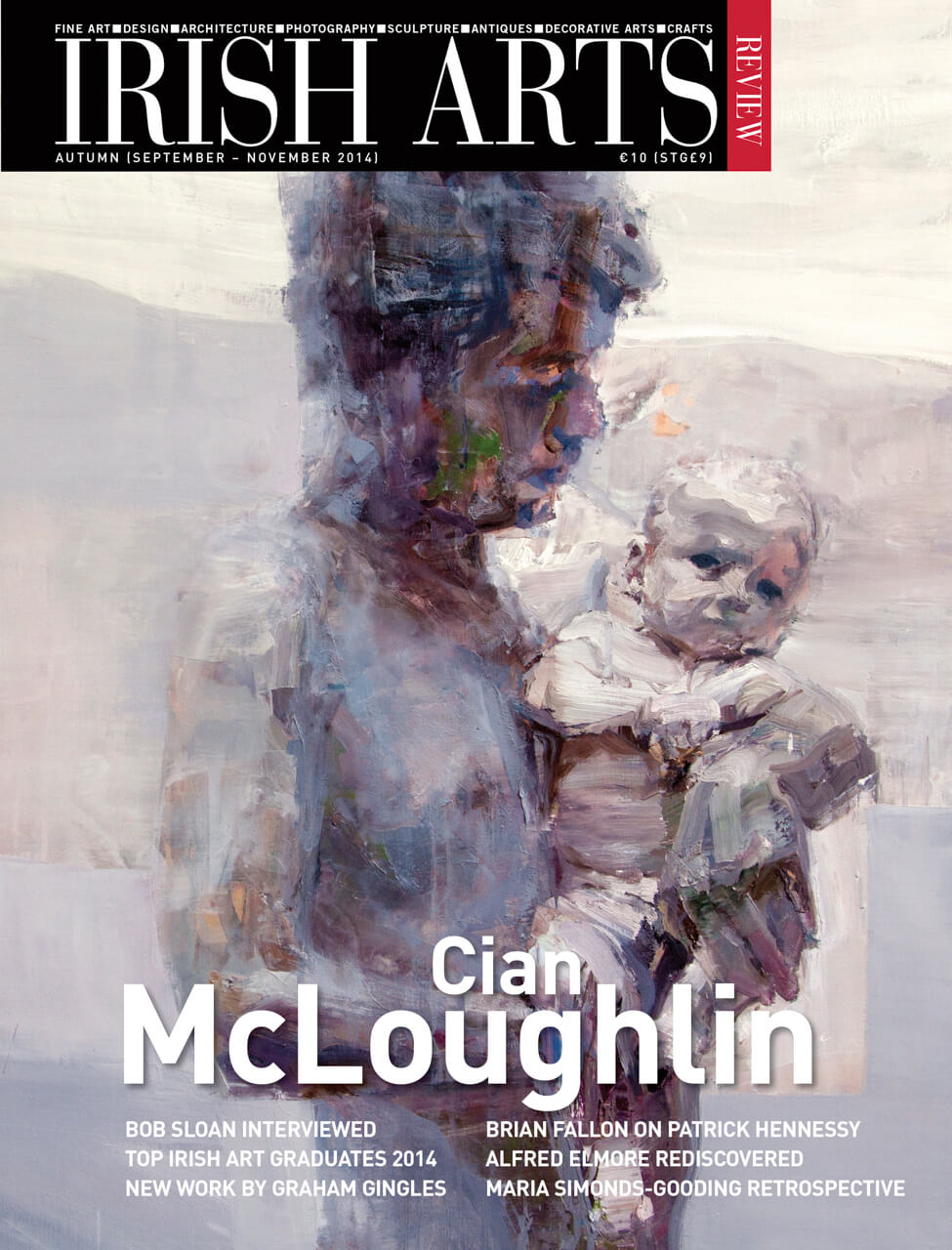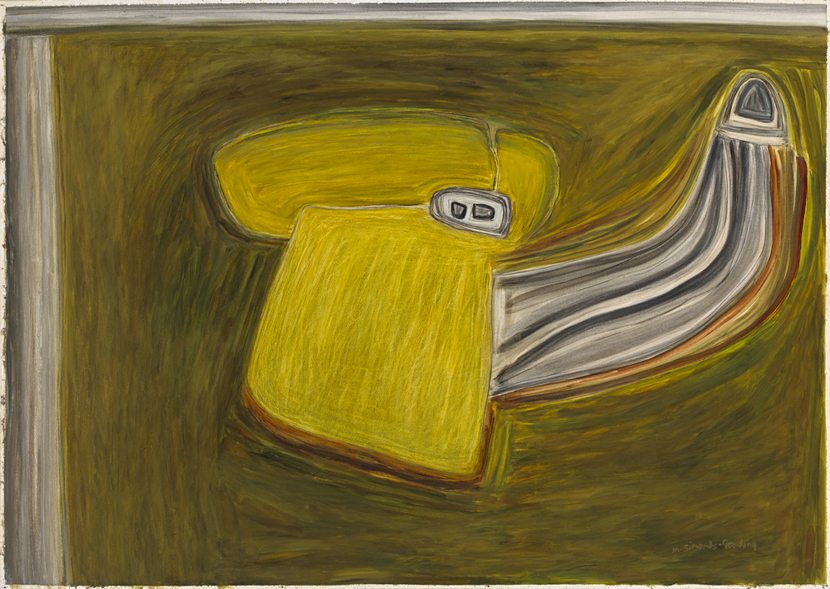

Carissa Farrell is transfixed by the shard-like glass birds and decayed flowers that combine to fascinating effect in Graham Gingles’s signature boxes at the Hamilton Gallery, Sligo
Gingles is known for his lifelong practice of producing boxes which imitate apothecaries’ cabinets filled with compartments of curiosities, sculptures, drawings and found objects. His work is enriched by an avid imagination that returns to examine themes of particular fascination to him: biology, death, sex, religious iconography and decay. This new work at the Hamilton Gallery, Sligo comprises both boxes and works on paper. A general air of tragedy and decay can be attributed to particular aspects of the work, such as the overall distressed quality of the materials; a ghoulish white paint that Gingles has untidily washed over elements of the frames and more explicitly, sculpted birds made from shards of broken glass.
Glass Bird I and Glass Bird III are hard to decipher and more than a little unnerving (Figs 3&4). They comprise window-like boxes with sills and balconies on which bird forms assembled from feather-shaped arcs of glass are perched. Glass Bird III raises its wings in a gesture of aggression and has a menacing appearance. It spikes out and is covered in blood and puss-like stains. Despite the work’s obvious grisly appearance it is cased beautifully, using various grades of timber and wood, including MDF, raw timber and a handsome stained plywood rarely seen in contemporary art practice. An understated glint of gold leaf is folded into the layers of wood and a kind of triumphal arch frames the shoulders behind the bird. Overall it has a masculine regal quality. Glass Bird I is more melancholic as the bird’s posture weighs downwards. The box is compartmentalized with a bird skull boxed off in a glass receptacle to the right (Fig 4). It would appear as a relief work if it weren’t for the deep glass box-lid that encases it like a religious relic, frozen in time forever. Gingles primary method of working with boxes and his interest in sex and death makes it hard for his work to avoid a kind of visual fetishism. One of the boxes in this exhibition Fleur de Mal II, possibly references Les Fleurs du mal, (Flowers of Evil) a volume of poetry by Charles Beaudelaire celebrating a gruesome kind of decadent eroticism. Ironically, it is made in the form of a tabernacle painted to create a fake render of beaten gold. Inside its three compartments, the contents reflect the work’s title: plastic lilies contaminated with a dirty brown liquid, a plaster cast that outlines the fleur de lis symbol and a glass dome encasing dead butterflies. The work suggests excessive fixation and even the tabernacle, a cabinet for the body of Christ, could symbolise the genesis of fetishment itself.
Gingles primary method of working with boxes and his interest in sex and death makes it hard for his work to avoid a kind of visual fetishism
A form of sexual taboo runs through another work, Godois Cabinet, in which a Victorian doll, naked from the waist up, peeps out from a shuttered compartment (Fig 5).
A page from a book Eucharistico returns to the theme of the tabernacle. Some time ago in this publication Gingles described the origins of his fascination with the subject, describing how he, as a Northern Irish Presbyterian experienced the Catholic Church up close for the first time, ‘‚Ķexposure to the visual delights of the Catholic Church was wonderful. Look at the theatre of the Mass, the mysteries of the Eucharist, and the Tabernacle in which it is kept‚Ķ’
The works on paper continue Gingles’ exploration of decay and death and highlight how darkness in life is close to the surface. Burnt House Tree and Frog in a single glance could be understood as a pastoral scene, but inscribed underneath ‘Study of Tree and Dead Frog by Graham Gingles’ illustrates a matter-of-fact attitude to death. In this and throughout his life’s work, Gingles demonstrates his unique and unapologetic freedom of expression in exploring the darker facets of human obsession and desire. In doing so, he makes work that is lovingly crafted, instinctive and honest.
Gingles recently completed an ambitiously-scaled work for The Mac, Belfast to commemorate a campaign initiated by Princess Mary during the Great War to send a gift to every serving soldier in time for Christmas 1914. Curator Hugh Mulholland, who felt the commission was particularly suited to Gingles’ practice, also wanted to challenge him to scale up his work. Installed in the Sunken Gallery at the Mac with a title borrowed from the war diaries of Robert McGookin, a soldier from Gingles hometown of Larne, At times like these men were wishing they were all kinds of insects (Fig) offers an immersive experience incorporating sound and the opportunity to walk through it. It is magnificent and dramatic and a considerable achievement given the enormity of the task and sensitivity of the subject.
Having listened to Gingles talk about the process of making the work, one can’t help but sense he discovered a whole new set of possibilities that will fuel his practice in the future.
Images ©The Artist. Photography Bryan Rutledge
Graham Gingles, ‘Bad flowers, glass birds and other ideas’, Hamilton Gallery, Sligo, 4 – 27 September 2014.
Carissa Farrell is a Curator and Arts Manager living in Dublin
McAvera B. , ‘Graham Gingles Cabinet Curiosa ‘, IAR Vol 22 no 4 (2005) p92



